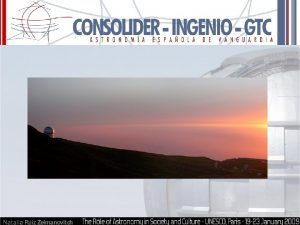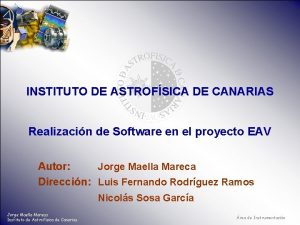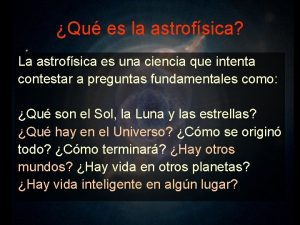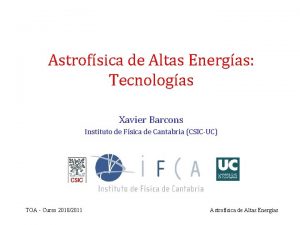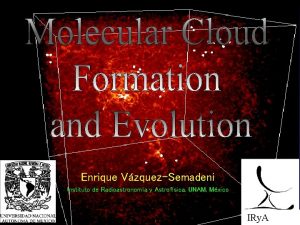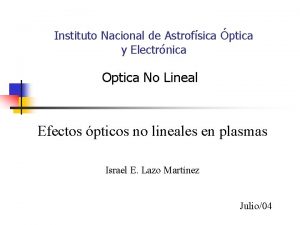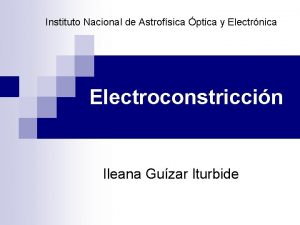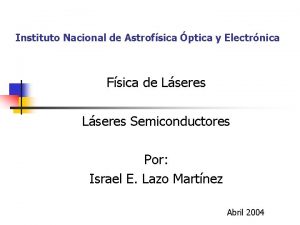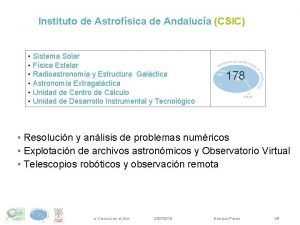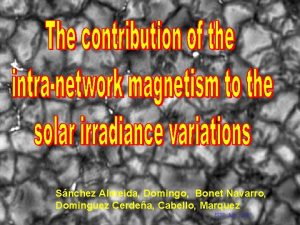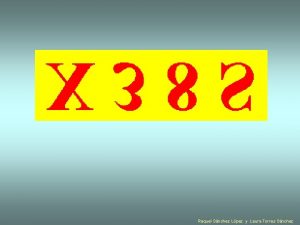J Snchez Almeida Instituto de Astrofsica de Canarias





































- Slides: 37

J. Sánchez Almeida Instituto de Astrofísica de Canarias, Spain Solar-B 5, Tokyo, November 2003

q What is quiet Sun? Why is it important? q Main observational properties ü Surface coverage ü Degree of tangling ü Magnetic field strengths ü Magnetic flux and energy ü Variations with the solar cycle q Origin of the QS magnetism (hints from theory) q Influence on the corona q Connection with Solar-B q Conclusions Solar-B 5, Tokyo, November 2003

Inter-Network Solar-B 5, Tokyo, November 2003

Inter-Network Quiet Sun aangular resolution mag. @ 0. 5” asensitivity @ 20 G a. VTT (obs. Teide), speckle reconstructed a. Unsigned flux density 20 G Domínguez Cerdeña et al. (03)) 1”x 1” Solar-B 5, Tokyo, November 2003

q Most of the (unsigned) magnetic flux and energy existing on the solar surface at any given time is in the quiet Sun. q It may play a significant role in all the physical processes pertaining to the global solar magnetic properties (dynamo, coronal heating, sources of the solar wind, …). q This role has been neglected so far. q Easy target for the new spectro-polarimeters. Solar-B 5, Tokyo, November 2003

Surface Coverage Between 90% at solar maximum and 99% at solar minimum (e. g. , Harvery 1994) Solar-B 5, Tokyo, November 2003

Degree of tangling The magnetic structures of the quiet Sun are not spatially resolved. Actually, the magnetic field vector varies within scales smaller than the smallest that we can resolve Resolution Element observer magnetic field vector 100 km 350 km º 0. 5” line of sight Solar-B 5, Tokyo, November 2003

IR spectral lines Visible spectral lines Solar-B 5, Tokyo, November 2003 SA et al. 2003 b

Stokes Profiles Solar-B 5, Tokyo, November 2003

Usual hypothesis Stokes V profiles observed in the Quiet Sun (SA & Lites, 2000) Solar-B 5, Tokyo, November 2003

polarization signals in complex (tangled) magnetic fields cancel out V 2 = -V 1 V 1+V 2 = Vobs = 0 Q 2 = -Q 1 Q 1+Q 2 = Qobs = 0 Solar-B 5, Tokyo, November 2003

The symbols correspond to observations of IN Quiet Sun Magnetic fields SA et al. (2003) Solar-B 5, Tokyo, November 2003

In short, due to the complex topology of the QS magnetic fields, All measurements are bound to underestimate the magnetic flux content of the QS fields. The measure of the magnetic field properties is a non-trivial issue. It involves a big deal of modeling and assumptions on the underlying atmosphere: Inversion Codes. Solar-B 5, Tokyo, November 2003

Magnetic Field Strengths Sunspots: Plage & Network regions: Inter-Network quiet Sun: Solar-B 5, Tokyo, November 2003

SA et al. 2003 b Solar-B 5, Tokyo, November 2003

SA et al. 2003 b; Socas Navarro & SA 2003 PDF: probability of finding a given field strength (per unit field strength). from Hanle effect from Zeeman effect Solar-B 5, Tokyo, November 2003

Solar-B 5, Tokyo, November 2003

q Most of the quiet Sun (IN) surface is covered by weak magnetic fields. more than 95% of the surface has q Magnetic flux density in the form of weak and strong magnetic field strengths. Flux (B < 100 G ; Hanle signals) = 50 G = 60 % of the flux Flux (B < 500 G) = 55 G = 75 % of the flux Flux (B > 500 G) = 20 G = 25 % of the flux 75 G < B < 120 G Solar-B 5, Tokyo, November 2003

Quiet Sun (visible + IR) AR + Network Solar-B 5, Tokyo, November 2003 AR+N data from Schrijver & Harvey, 94, SPh, 150, 1 Quiet Sun (Hanle)

q Energy density in the form of weak and strong magnetic field strengths. Energy (B < 100 G ; Hanle signals) = 19 % of the mag. energy Energy (B < 500 G) = 24 % of the mag. energy Energy (B > 500 G) = 76 % of the mag. energy Solar-B 5, Tokyo, November 2003

Variation along the solar cycle Unknown, but it is one of the clear observational targets. To be achieved thanks to the new synoptic magnetograms (e. g. , SOLIS www. nso. noao. edu/solis/ ). Claims on the variation: ü Variation of some 100% (Faurobert et al. 2001). Refers to the weakest fields, deduced from Hanle signals. ü No flux density variation along the cycle within 40% (SA 2003 c). Refers to the tail of k. G of the PDF ü No variation of hanle signals (Trujillo-Bueno & Shukina 2003). If existing, the variations are negligible as compared to the variation observed in active regions. Solar-B 5, Tokyo, November 2003

Options for the origin of the quiet Sun magnetic structures ü Debris from active regions produced by the global solar dynamo ü Turbulent local dynamo driven by granulation. (Petrovay & Szakaly 1993, Cattaneo 1999, …) ü Turbulent global dynamo (Stein & Nordlund 2001, Schussler et al. 2003, etc. ) Solar-B 5, Tokyo, November 2003

Debris from Active Regions: Unlikely ARs emerge (and so decay) at a rate of 6 x 1021 Mx day-1 IN magnetic flux > 1. 2 x 1024 Mx then IN cannot decay in less than 200 days, (200 days = 1. 2 x 1024 Mx / 6 x 1021 Mx day-1) otherwise they would be gone before fresh AR flux replenishes it. 200 days is too long since the IN fields vary in timescales of min … Lifetimes found in the literature are hours. Solar-B 5, Tokyo, November 2003

Turbulent local dynamo Bz Temperature 1” Cattaneo & Emonet, 2001 Solar-B 5, Tokyo, November 2003

SA et al. (2003) Solar-B 5, Tokyo, November 2003

Turbulent global dynamo Unclear how to distinguish this mechanism from the local dynamo. ü complex topology ü no variation along the cycle ü tight coupling with granular motions Stein & Nordlund Solar-B 5, Tokyo, November 2001 2003

Solar-B 5, Tokyo, November 2003

Traditionally, the influence of the IN fields on the coronal magnetic field is neglected. Argument: the magnetic field is so complex that most of the field lines close in very low loops and never reach the corona. However: ü The base of the corona is very low: 2500 km (VALC) ü Cancellation is often non-local (e. g. , Schrijver & Title, 2002) so a fraction actually makes it to the corona. ü The IN flux is so large that a small fraction makes a significant absolute contribution Solar-B 5, Tokyo, November 2003

force free extrapolations 1000 km < height < 2000 km loop height < 500 km Hoffman et al. 2003 Solar-B 5, Tokyo, November 2003

prominences magnetic energy equals thermal energy density Hoffman et al. 2003 Solar-B 5, Tokyo, November 2003

The topology of the network fields reaching the corona is significantly modified (in a non-trivial way) by the presence of IN fields. Schrijver & Title (2003) Solar-B 5, Tokyo, November 2003

IN fields would be routinely detected with normal mapping of the spectropolarimeter of SOT. (however, only the tail of k. G IN fields) 0. 3” Solar B resolution Solar-B 5, Tokyo, November 2003

Studying the IN magnetism is appealing, since it allows to address basic problems of solar physics (solar dynamo, coronal structure and heating, sources of the solar wind, magnetic decay, …) Because of the complications of the magnetic field, non-trivial magnetic field measurements are needed. Stokes profiles are needed for this task (provided complex magnetic fields are allowed for by the inversion techniques). Solar-B 5, Tokyo, November 2003

è The quiet Sun is a component of the solar magnetism whose role has been neglected so far, but whose true role is not understood yet. è Quantitatively important in terms of the global magnetic properties (e. g. , carries more unsigned flux than all active regions at the solar max. ) It occupies most of the solar surface. è Complex magnetic topology. The diagnostic of their properties based on the observed polarization is a non-trivial issue. Stokes profiles + inversion techniques needed! It is not possible to describe the magnetic field of a IN pixel with a single magnetic field vector. Solar-B 5, Tokyo, November 2003

è Distribution of magnetic field strengths: from 0 to 1. 5 k. G. è (? ) Magnetic Flux and magnetic energy dominated by the tail of k. G fields. è(? ) fairly easy to detect with high angular resolution (easy to achieve by the new generation of ground based 1 m-class + Adaptive Optics or space-borne magnetometers, line SOLAR-B. ) è(? ? ) No strong variation along the cycle. Refers to the tail of k. G fields detected in visible magnetograms. Solar-B 5, Tokyo, November 2003

è(? ? ) Does it reach coronal heights? Probably it does in the quiet Corona è(? ? ) Coronal heating due to nano-flares? è(? ? ) Role within the global solar dynamo responsible for the 22 years solar cycle: passive, leading role … è(? ? ) Responsible for the chromospheric basal flux. è(? ? ) Relationship with the origin and acceleration of the solar wind? Solar-B 5, Tokyo, November 2003

Solar-B 5, Tokyo, November 2003
 Elisa snchez
Elisa snchez Yudy snchez
Yudy snchez Ccplans
Ccplans Diego snchez
Diego snchez Bomberos canarias
Bomberos canarias Ilas canarias
Ilas canarias Relieve de las islas baleares
Relieve de las islas baleares Ley suelo canarias
Ley suelo canarias Canarias
Canarias Ilas canarias
Ilas canarias Augusto benvenuto
Augusto benvenuto Luis almeida e sousa
Luis almeida e sousa Faculdade almeida rodrigues
Faculdade almeida rodrigues Teddy de almeida
Teddy de almeida Bíblia almeida revista e atualizada ppt
Bíblia almeida revista e atualizada ppt Alicia de almeida
Alicia de almeida Thiago almeida barroso
Thiago almeida barroso Escola estadual joelina de almeida xavier
Escola estadual joelina de almeida xavier Karoline almeida rangel
Karoline almeida rangel Jonas almeida
Jonas almeida Rodolfo abrantes tatuagem
Rodolfo abrantes tatuagem Oscar ribeiro
Oscar ribeiro Almeida-pineda algorithm
Almeida-pineda algorithm Nossa bandeira guilherme de almeida
Nossa bandeira guilherme de almeida Anemia pernisiosa
Anemia pernisiosa Pierre d'almeida telles filho
Pierre d'almeida telles filho Marco antonio garcia de almeida
Marco antonio garcia de almeida Iscs - instituto superior de ciencias de la salud
Iscs - instituto superior de ciencias de la salud Instituto de administración y comercio estado de israel
Instituto de administración y comercio estado de israel Instituto white star
Instituto white star Vasco da gama
Vasco da gama Instituto nueva inglaterra
Instituto nueva inglaterra Instituto educativo panamericano
Instituto educativo panamericano Logo del instituto catolico karol wojtyla
Logo del instituto catolico karol wojtyla Instituto federal
Instituto federal Instituto escalae
Instituto escalae Instituto tecnologico de la zona maya
Instituto tecnologico de la zona maya Divina pastora mataderos
Divina pastora mataderos








































